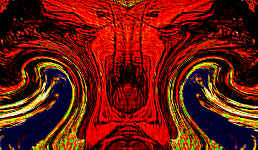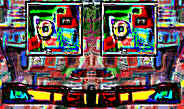— He began as an itinerant painter of topographical landscapes along the banks of the Ohio River c. 1854, influenced by such landscape artists as Worthington Whittredge and George Inness. In 1863–1864 Wyant moved to New York, where he was impressed by the paintings of the Norwegian artist Hans Gude in the Düsseldorf Gallery. This led him to work with Gude in Karlsruhe, Germany, in 1865. On his way both there and back, he studied paintings by Constable and used a more painterly technique especially for views of Ireland, for example Irish Landscape (1865, 30x51cm). Gude’s influence in Germany was very strong, when Wyant painted hard-edged, but broad and expansive landscapes such as Tennessee (formerly The Mohawk Valley) (1866).
— Wyant was born on 11 January 1836 at Evans Creek, Tuscarawas County, Ohio. Before he was two his family moved to Defiance, Ohio, where he attended school and was apprenticed to a local harness maker. In the 1850s, while working as a sign painter in Port Washington, Ohio, Wyant decided to pursue a career as an artist. In 1857 he visited Cincinnati, where he saw landscape paintings by George Inness [1825-1894]. Wyant was greatly impressed by Inness' works and resolved to meet the artist, which he did he New York in 1859. Inness apparently encouraged Wyant in his aspirations to be a landscape painter, and helped arrange for financial support for the young artist from Nicholas Longworth, and important Cincinnati patron. Longworth funded Wyant's studies in New York in 1860 and in Cincinnati the following two years.
Wyant moved to New York in 1863 and exhibited a painting at the National Academy of Design in 1865. While in New York he saw works by a number of Düsseldorf-trained artists, and was particularly drawn to the landscapes of the Norwegian painter Hans Friedrich Gude. In 1865 Wyant arranged to study with Gude, who was then teaching at Karlsruhe, Germany. He apparently did not find Gude a satisfactory teacher, for he departed within the year. On his way back to the United States he visited Paris and London and travelled in Ireland. He admired the landscapes of both J.M.W. Turner and John Constable, and was especially influenced by the latter's fluid handling of paint.
Wyant resettled in New York in 1866 and began to develop a looser, more atmospheric style that was less detailed and more suggestive than pictures by Düsseldorf artists or the works of Hudson River School landscape painters. In 1867 he joined the American Society of Painters in Water Colors and the following year he as elected an Associate of the National Academy of Design; he was made a full member in 1869. In these years he exhibited regularly in New York and elsewhere, and made many sketching trips. He also renewed his friendship with Inness, whose work continued to be a major influence. Wyant joined a government expedition to explore Arizona and New Mexico in 1873, but declining health and the hardships of travel forced him to abandon the trip and return east. He subsequently suffered a stroke that left his right arm paralyzed, forcing him to learn to paint with his left hand. Between 1874 and 1880 he occupied a studio in the YMCA building on 23rd Street in New York, spending his summers in the Adirondacks. He became a member of the Society of American Artists in 1878 and also joined the Century Association.
In 1880 Wyant married Arabella Locke, one of his students, and the couple began spending more time out of New York, especially in Keene Valley in the Adirondacks. In 1886 his entire right side became paralyzed and he and his wife moved to a house in Arkville, in the Catskill Mountains. Although his limited mobility now made sketching trips impossible, Wyant continued to paint, creating atmospheric, freely brushed landscapes composed largely from memory. He was considered one of the US's premier landscape painters at the time of his death in New York in 1892. During the early decades of the twentieth century Wyant's reputation in US art soared, but his standing has declined dramatically in recent years.
— LINKS
–- Rocky Ledge, Adirondacks (1884, 110x85cm; 667x520pix, 79kb _ .ZOOM to 1000x779pix, 163kb _ .ZOOM+ to 1500x1168pix, 225kb)
— A Gray Day (1885, 41x57cm; 470x653pix, 219kb _ ZOOM to 753x1047pix, 463kb) _ Do you think it is a grade-A picture? The pseudonymous Alex Andrew Hevenwig Wynotant has derived from it:

_ A Really Dull Gray Picture of a Really Dull Gray Day That Does Not Deserve a Grade-A, But At Most an F, and is Best Seen Small As Here >>>. But, if you must, go ahead at your own risk and ZOOM to 753x1047pix, 16kb, or frame it (235kb). Too dull? make it more colorful (278kb).
— Falls of the Ohio and Louisville (1863, 101x142cm; 732x1010pix, 104kb _ ZOOM to 1098x1515pix, 182kb)
— In the Keene Valley, New York (1872, 36x57cm; 679x1107pix, 71kb)
— Sun in Kentucky (1869, 43x71cm; 651x1086pix, 75kb)
— Sunset in Kentucky (1869, 43x71cm; 651x1086pix, 65kb)
— Mount Washington from the North Conway Intervale (36x56cm; 317x500cm; 43kb)
— Landscape near Arkville (1889 51x77cm; 344x512pix)
— Spring (38x59cm; 344x528pix, 64kb)
— 30 images at the Athenaeum
—(051128)

